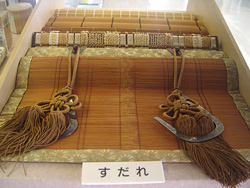Bamboo screens
Bamboo screens in Japan have a long history that goes back to the Heian Period. The original form of the current tatami room was based off of the bamboo screens used as a partition and decoration in the royal court.
Manufacturing of bamboo screens using high quality bamboo at the foot of Mt.Kongouzan became prevalent in the Tondabayashi and Kawachi-Nagano area and formed into a local industry.
The Minami-Kawachi region has a large amount of high quality long-jointed bamboo and the manufacturing of bamboo screens is said to have become more prevalent when the manufacturing method transmitted to Kyoto during the first part of the Edo period. Elegant and magnificent bamboo screens made of natural materials are used as room partitions and for blocking out the sun and have a gentle beauty that has become an essential part of traditional Japanese living.
During the summer, many houses would remove their sliding doors and use bamboo screens.
Views of the garden through the bamboo screen were beautiful and brought a sense of comfort even though the scene was a familiar sight.
In this way bamboo screens have continued to be a part of Japanese culture and while they have existed as a traditional craftwork using a manufacturing process from long ago, bamboo screens are also used in interior modern design and this has created new demand for bamboo screens as an industrial product.
Inoue Sudare Co., Ltd. is a bamboo screen manufacturer in Kawachi-Nagano that operates a Bamboo Screen Museum that anyone can visit.

| Manufacturer's Association | Bamboo Screen Museum |
|---|---|
| Location | 1014-1 Amano-cho, Kawachi-Nagano 586-0086 (inside Inoue Sudare Co., Ltd.) |
| Phone | 0721-53-1336 |
| Fax | 0721-54-6506 |
| HP(URL) | https://www.sudare.com |

